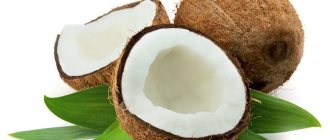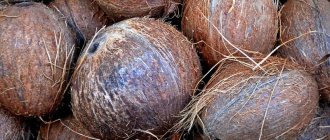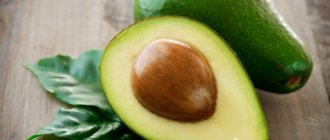On the shelves of our stores, the beloved coconuts have long been side by side with the usual nuts and fruits. In addition to their pleasant taste, they contain folic acid, which is so necessary for all of us, which is responsible for cell growth throughout the body, their renewal and restoration. Women especially need it during pregnancy. Coconut contains a lot of vitamin C, proteins, fats and carbohydrates. In order to maintain all the beneficial properties of this product, it is very important to store it correctly at home.
How to choose a coconut in a store
When buying a nut in a supermarket, carefully inspect it from all sides for damage. There should be no cracks or chips on it. The surface of the peel should be equally rough and evenly colored brown. Coconut fruits do not ripen during storage, so if you notice green spots, do not buy. The nut will not ripen and will taste unpleasant. There are darker 3 dots at the bottom. Press around them on all sides. There should not be any softer areas. If found, this means that the nut is damaged and is not suitable for consumption. Shake the fruit near your ear. You should hear a splash of liquid. If not, then the nut is dry and there is no need to take it. Dried fruit is much lighter than fresh fruit. To compare, hold several nuts and choose the heaviest one.
What to look for when choosing
First of all, you need to decide what type of product is needed - refined or unrefined. Its appearance, aroma and storage characteristics will depend on this. Refined oil is white in color and odorless, while unrefined oil can be light yellow and have a pleasant coconut aroma.
The composition should not contain any additives, both visually and on the label. By carefully studying it, you can protect yourself from counterfeiting.
Coconut oil can also be cold or hot pressed. The first option is more gentle, so more benefits are retained in the final product. Hot pressing allows you to get a larger amount of squeeze, with some loss of useful components. It is what is most often used for culinary purposes.
Signs of rancidity
Despite the fact that coconut butter is stored for a long time and without special requirements for conditions, it can spoil. You can determine a rancid product quite easily by external signs:
- unpleasant or strange odor. The smell of smoked meats or sausage is a clear sign of staleness;
- bright yellow color. Normal color may be light yellow or golden in unrefined, and pure white in refined. But if the color becomes bright, then the product is spoiled;
- A bitter taste indicates rancidity.
These signs may appear over time due to improper storage or warn against purchasing an already damaged product.
How to store an opened coconut
Soon the pulp begins to deteriorate and become bitter, and if the fruit is too cold, the pulp will become watery, which will also spoil its taste. So, if you want to enjoy coconut, choose fresh one from the store and eat it right away. And yet, how and where to properly store peeled coconut at home in order to maximize its shelf life?
Opened nuts should definitely only be stored in the refrigerator.
Carefully open the nut. Pour the coconut milk into a suitable container. Take a glass jar or bottle, one that you can then tightly close with a lid. Strain the milk through cheesecloth or a fine strainer, pour into the prepared container, close the lid tightly and place in the refrigerator. A film similar to cream forms on its surface. It must be removed before use.
Signs of a spoiled product
A spoiled product should not be consumed, as this may cause poisoning. Below are signs that will help you determine that a coconut has gone bad and should be thrown away.
- A whole coconut does not make gurgling sounds when shaken (there is no liquid inside, or there is little of it); there are spots, dents and cracks on the surface of the fruit; an unpleasant, pungent odor emanates from the shell; presence of mold and rot.
- Coconut water has a sour smell and sour taste.
- The color of the pulp has a yellowish-pinkish tint; consistency is soft, heterogeneous; the presence of gray or greenish inclusions. Pay attention to the presence of a subtle white coating. All these are signs of a spoiled fetus.
- Dried coconut has a rancid, unpleasant taste and smell; The chips are oily, not crumbly.
- Milk is considered spoiled if it has acquired a foreign smell or taste, and a grayish tint or pinkish mold has appeared.
In conclusion, it can be noted that it is necessary to split the fruit only before eating it. When choosing a nut, you should carefully inspect it for any visible damage. Dried coconut lasts the longest. To achieve the longest shelf life, follow the rules and recommendations given in the article.
How to store coconut meat
The coconut meat is peeled and placed in a container with a tight-fitting lid. And they also put it in the refrigerator. But the shelf life of the pulp in the refrigerator is only 2 days. If it has become soft, you can refresh it by filling it with water, but the taste will noticeably suffer from this. The best use for such pulp is not to eat it in this form, but to use it to prepare some dishes. If the nut begins to taste bitter, it means that it has spoiled, and there is nothing else to do but throw it away.
In a refrigerator
After opening, the coconut must be placed in the refrigerator, where it retains its juiciness and taste for about two days. Even in the refrigerator, the length of time a nut is stored depends on the temperature.
For example, at temperatures from 0 to +5 degrees, the fruit will retain all its properties for seven to ten days. If the temperature is above +5, you should not keep the nut for more than a week. But if the temperature is stable at +5, the coconut will be fresh for two to three months.
When opening the nut, it is better to store the pulp and milk separately from each other. This will increase their freshness.
Shelf life of coconut
If you store coconut on a shelf in the refrigerator, the shelf life of a whole coconut increases to 30 days. Some believe that up to 2.5 months. You can store a closed coconut in a kitchen cabinet at room temperature, but no more than a week. With longer storage, the fruit begins to dry out and deteriorate, losing its taste and beneficial properties.
An opened coconut doesn't last long. Even if stored in the refrigerator, it will stay fresh for at most 2 days. Coconut milk, poured into a glass container and tightly closed with a lid, can be stored in the refrigerator for up to 7 days.
This can be done by freezing both the coconut milk and the pulp. Before pouring the milk into ice molds, you need to carefully remove the fat that has formed from the surface, otherwise it will not harden and will then flake off. The shelf life of frozen coconut milk is up to 2 months. It is best to grind the pulp in a blender. Place the resulting coconut crumbs in a vacuum bag and put them in the freezer. It should be used immediately after defrosting and is best used in cooking. Frozen coconut can be stored for up to 1.5 months.
Culinary tricks
Since coconut milk is an exotic drink, its characteristics should be taken into account when preparing food.
Coconut milk is not boiled in its pure form, as after boiling the drink will begin to curdle. During cooking, milk is added at the very last stage, heating it, but not bringing it to a boil.
Yes, you can cook oatmeal, semolina and rice porridge with coconut milk, but the drink must be diluted with water in equal quantities.
Coconut milk can be added to coffee immediately after preparing it. Dried milk is first poured into a mug, and only after that the coffee drink is poured into it.
The amount of milk is calculated based on the tastes and preferences of the person cooking.
Before you froth the coconut milk, you need to cool it by keeping it in the refrigerator for 12 to 24 hours. Then you need to open the jar (without shaking the contents), separate the thick part (cream), transferring it to another container. After this, the cream can be whipped with a whisk or mixer until stiff peaks form.
Powdered coconut milk is diluted with cold or warm water. For 200 ml of water you will need 2-3 tbsp. l. powder. First, the dry substance is poured into the container, and then water is gradually poured while constantly stirring the liquid.
When preparing sauces, coconut milk can be replaced with low-fat cream (10-15%). You can add regular milk and a little coconut to desserts without losing taste.
Knowing some tricks on how to handle coconut flakes can speed up cooking and make the dishes themselves very tasty and aromatic.
Coconut flakes are widely used in cooking. Most often it is used in the preparation of desserts: added to rolls, cakes and pastries, creams and sweet sauces are prepared with it. Coconut pulp is often used as a topping: it is used to decorate candies, curd cheeses, bars, cookies and chocolate bars.
It may seem unusual to use chips in savory dishes. Haute cuisine chefs add it to meat products to give them special piquancy and sophistication. And in Asian cuisine, an unusual sauce is popular - a mixture of chili peppers and coconut flakes.
What does it go with?
Coconut pulp goes well with almost all foods. It goes great with sweet chocolate and ice cream, nuts and fruits, meat and fish. It is used in sauces for hearty dishes, and as a breading for frying fish and cauliflower.
How to make it soft?
When the shavings have been sitting for a long time and have turned into a solid mass, the question arises: “How to soak coconut shavings?” You can try to save the product if it has not absorbed foreign odors. If the aroma of coconut pulp has changed, then the taste will be unpleasant. To soften coconut shavings, place them in a deep plate, add a small amount of water and leave overnight. The next morning, the chips will lose their former hardness and will be ready for use.
Multi-colored shavings are perfect for decorating baked goods. You can change the color of the chips using dry food coloring. To do this, pour the desired amount of coconut flakes into a plastic bag and add a little dye. The bag is tied into a knot, and then shaken and squeezed with your hands until the chips turn a new color.
A cake decorated with coconut shavings is the most popular decoration option. The dessert can be sprinkled with shavings only on top or added additionally on the sides. While it’s easy to sprinkle the top of the cake, difficulties arise with the side surface.
Another original way to decorate is to decorate the surface of the cake with cream and sprinkle with shavings. To do this, prepare any type of cream, which is placed in a culinary syringe. By squeezing out a small amount of the mixture, the cake is dotted with cream and sprinkled with coconut flakes on top.
The option of replacing coconut shavings depends on the recipe and the desired effect. You can replace coconut pulp:
- Grated nuts, confectionery powder or grated chocolate. This method is suitable for baked goods in which coconut flakes are used as a decoration and do not affect the taste.
- Coconut oil. In the filling or baking cream, you can replace the shavings with coconut oil. It will completely replicate the taste and smell of the original product.
- Cumin, cinnamon or ground crackers. This replacement option is suitable for savory dishes.
In recipes where coconut is the main ingredient, it cannot be replaced. It's hard to imagine a coconut cookie, cupcake or bounty cake without the main ingredient.
Drying
Drying coconut meat is another way to store this product for a long time. The pulp is crushed (it is most convenient to do this in a blender, since the coconut pulp, after opening, is quite hard and difficult to grind in any other way). Place the finished crumbs on parchment paper and send them to the oven, where at a temperature not exceeding 60 degrees they dry for 4-5 hours until completely dry. Then leave to cool. After this, they are laid out for storage (preferably in a ceramic jar or cotton bag). You can put a paper napkin at the bottom to absorb any random liquid. It is best to store in a dark, closed cabinet, away from moisture.
Storage requirements
In order for coconut to be stored longer, it needs to be provided with optimal conditions. Temperature, humidity and light parameters are of great importance.
Temperature
Before opening the peel, the nuts lie well in cool and dry rooms. In this case, the temperature should not exceed +20 degrees. When storing coconut for more than 1 month, there is a risk of its liquid turning sour and the pulp drying out.
Illumination
The nut should be stored in a dark place. It should not be exposed to direct sunlight.
Humidity
Air humidity parameters must be maintained at 70%.
Coconut oil
Coconut oil is a universal product that is just gaining ground among edible oils on our Russian market. It has a light coconut aroma and a slightly sweet taste. Excellent for baking a variety of pies, cookies, buns and cakes, adding a slightly piquant taste to baked goods. Coconut oil has the important property of not losing its qualities during heat treatment.
This oil is of plant origin, therefore it contains sufficient quantities of Omega-3 fatty acids, which are necessary for our body and which the body itself cannot produce, but receives only from food, including vegetable oils.
Coconut oil also helps burn fat, which is important when losing weight. It is recommended to use it in its pure form, 1 tbsp. spoon before meals to improve digestion and speed up metabolism. It is also recommended for lowering blood sugar in diabetes mellitus. Helps treat coughs and other manifestations of colds and viral diseases.
Several recipes for using coconut oil in your diet:
- place nuts in a blender, add coconut oil, stir, you will get a very tasty nut butter for breakfast tea, and also very filling;
- replace your salad oil with coconut oil, this will give your dishes a special taste;
- very good to use in baking;
- perfect for porridge, replacing butter;
- We are more accustomed to using coconut oil as an excellent cosmetic product.
Humidification:
- It is difficult to find a more effective moisturizer in cosmetology than coconut oil. Perfectly nourishes dry hand skin even without the use of any additives. It is enough to rub this oil in, and the skin will become soft and elastic;
- mask for moisturizing and nourishing hair. Mix coconut oil with honey, apply to hair, leave for 40 minutes, rinse with shampoo;
- moisturizing and antibacterial face mask. Mix coconut oil with honey, apply to clean facial skin, hold for 15 minutes, rinse with warm water;
- moisturizes lips better than any hygienic lipstick.
Anti-aging benefits of coconut oil: Apply a little oil around the eyes and massage lightly. Removes wrinkles.
Household use:
- will remove chewing gum even from hair and carpets;
- coconut oil will remove dirt in the bathroom;
- will remove rust from metal objects.
Health:
- whitens teeth. Every day, hold a tablespoon of coconut oil in your mouth for 10 minutes;
- relieves skin irritation. Mix coconut oil with calendula and apply to the affected area;
- relieves stress. Massage the oil into your temples and scalp;
- relieves itching from insect bites.
What are the benefits of coconut?
Now about the benefits of the product. It is recommended for every person to consume coconut at least sometimes, and here’s why:
- Coconut is known throughout the world as a powerful aphrodisiac. It is added to many medications related to men's health. Both the pulp and milk of coconut are considered beneficial for men.
- Due to its high fiber content and B vitamins, it helps in the fight against atherosclerosis.
- Normalizes cholesterol and prevents the formation of plaques on the walls of blood vessels.
- Helps with digestive problems, is used as an anthelmintic and antimicrobial agent.
- It has a positive effect on vision - coconut pulp contains large amounts of vitamin A.
- Coconut oil has a soothing and regenerating effect, which is why it is so popular in the cosmetic industry.
This is interesting:
How to keep lemon from drying out at home.
Features of pomegranate storage.
How to choose good coconut oil
Good coconut oil smells like fresh coconut, this smell is very subtle, sweet and unobtrusive. You only need to choose unrefined oil. It has not been subjected to heat treatment, and accordingly, it has retained all its beneficial properties. Edible oil can be used in cosmetology too. It is better to buy in a glass container with a wide neck; after testing various oils from many countries, we preferred the product made from the USA - ALL GOOD ELEMENTAL HERBS.
Main selection criteria
To keep a product fresh for a long period of time, you need to choose it correctly.
Appearance
It is necessary to buy only ripe coconut. During transportation, this fruit does not ripen. It is acceptable to eat a nut that has a rough shell. It should be brown in color with no green areas.
Holes
There should be holes at one end of the coconut. There should always be 3 of them. It is important that these places are dry and clean. There should be no mold or rot on the surface. It is important that the holes do not bend even under strong pressure.
How to store coconut oil at home
Always store the container with the product in a cool, dark place at room temperature. Then it will be convenient to use it as a cosmetic product with a liquid consistency. You can store oil in the refrigerator for cooking. It will become thick. This product differs from other similar products in its longer shelf life, up to one year. Natural high-quality oil thickens at low temperatures and acquires a liquid consistency at above-zero temperatures.
In ampoules and capsules
Quite often, coconut oil is sold in ampoules or capsules made of glass or plastic. In this case, there is a risk of purchasing a damaged product or a fake. To ensure the good quality of coconut oil, open one of the ampoules. It should be liquid and transparent with a golden hue. If the product is bright yellow, then it is already spoiled.
An opened capsule or ampoule will be difficult to close tightly, so try to consume it within 24 hours.
As a rule, ampoules and capsules with oil are sold in cardboard boxes. Never throw them away after opening. They are designed not only for convenient placement of capsules (ampoules), but also to protect them from direct rays of the sun.
Don't know where to store coconut oil in capsules and ampoules? The place should be dark and cool. But do not put them on the refrigerator shelf immediately after purchase. You can place them there only when the expiration date comes to an end, about 3 months in advance, this will extend their shelf life
It is important to mention that storing coconut oil in the freezer, in any form, is strictly prohibited. Low temperatures will ruin it
Why is the coconut empty?
Inside an unripe coconut
there is coconut water.
… Gradually, under the influence of the oil secreted by copra, coconut water hardens and settles on the walls of the nut in the form of its pulp. Therefore, young coconuts
are filled with water and their flesh is soft and tender, while a ripe
coconut is empty
and has hard flesh.
Interesting materials:
What does a fox tattoo on your leg mean? What does a lord tattoo mean? What does a small bird tattoo mean? What does a crown finger tattoo mean? What does a shoulder tattoo mean? What does a spider tattoo on your leg mean? What does a feather tattoo on the arm mean? What does a feather tattoo on the neck mean? What does a feather tattoo on a girl’s body mean? What does a feather tattoo on the body mean?
Saving methods
The following describes whether it is necessary to store the nut in the refrigerator so that it does not spoil, where else you can keep the product and whether it can be dried.
In a refrigerator
It is recommended to store coconut only in the refrigerator.
Even when buying fruit in a supermarket, preference should be given to those specimens that have been stored in the cold. There, in the store, you need to pay attention to the label stuck on the nut, which should indicate the basic storage conditions and expiration date.
A whole nut can last up to 3 months on a shelf, but an opened one can last for a couple of days. And this is one of the advantages of this storage method: the natural fruit with all its beneficial substances will always be at hand for the specified period.
But a significant drawback will be the fact that the coconut will not be suitable for storing fruit if there are already apples, bananas, pears, melon and beets there. All these fruits produce volatile ethylene gas, which negatively affects the “keeping quality” of the nut.
In the freezer
Cold will significantly extend the shelf life of the coconut. The advantage of this storage method is the preservation of the beneficial properties of the fruit to the maximum and a fairly long period of its preservation. A significant disadvantage is the need for additional space in the freezer to accommodate containers or bags of coconut raw materials.
Attention! There is no need to defrost the pulp before use, otherwise it will turn into shapeless porridge. Coconut raw material will not tolerate repeated freezing.
Drying
The undoubted advantage of this method of storing coconut pulp is the maximum possible shelf life - approximately about a year, subject to the recommended conditions.
Another undeniable plus: dried raw materials do not take up much space. The main disadvantage of this method of “extending the life” of coconut is the loss of almost all useful substances as a result of exposure to high temperatures.
Without refrigerator
It is better to store coconut in a cellar, but not everyone has one. Most often, the fruit is stored at room temperature, which does not have the best effect on its quality. It can be relatively reassuring to know that this storage method is available to everyone.
Coconut Cleaning Methods
People have tried many different options for opening a coconut, using special tools and without using available tools.
Cleaning without a hammer
Sometimes a nut is opened not at home, but in nature; special tools may not be at hand.
- Press the coconut onto the corner surface of the house, which should be made of stone or brick.
- Press down on the coconut, making rotational movements.
- Continue exposure until the coconut splits.
Cleaning with a knife
Prepare a heavy, strong knife:
- Take the nut in your palm, holding it tightly.
- Place a bowl under the coconut to collect the milk.
- Find a seam on the surface that is located exactly in the middle of the two eyes and runs along the entire nut.
- Tap the seam with a knife while rotating it in your hand.
- Continue the influence until the fruit splits (if you follow the rules, 2 identical halves should remain in your hands).
You should control the force of the blow, trying not to hit your own hands.
How to crack a coconut with a hammer
You will need a plastic bag and a hammer.
- Using a screwdriver or a sharp large nail, make a small hole through which to drain the milk from the nut.
- Place the fruit in a bag and tie it.
- Place the bag on a flat, hard surface (ideally the floor).
- Hit the crust firmly with a hammer.
- After the fruit splits, remove from the bag and remove any remaining skin.
Cleaning with improvised tools
Use sharp and heavy objects, this is the only way the dense skin can give way and open access to the aromatic pulp.
- Press the fold at the junction of the halves with a knife, holding the nut in one hand, and tapping with the other, while simultaneously rotating the fruit around its axis.
- Wrap the nut in a towel or wrap it in cling film and place it on the table or floor. Hit the coconut with a hammer until cracks form in the husk.
- Holding the fruit in your hands, tap the seam with a knife, after a while turn and continue. Then try to split the fruit in two using a tool inserted into the crack. Be careful not to hurt your hands.
- Cut the fruit in half using a hacksaw, or saw off the upper nut part, which is then used as a lid.
Cleaning using the “hot-cold” method
Coconut can be peeled quite easily if you use alternating exposure to cold and heat.
- Remove the liquid from the nut, otherwise it will explode when heated.
- Place the fruit in the microwave for 5 minutes or oven for 15 (at a temperature of 200 degrees), then immediately put it in the freezer for 15-20 minutes.
- Now, using a hammer, tap the entire seam until cracks appear on it.
- Afterwards, it is easy to divide the nut into 2 parts and remove the shell.











